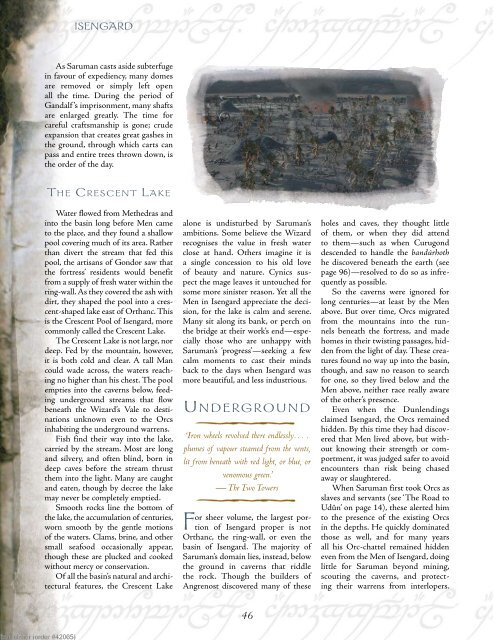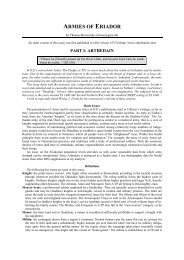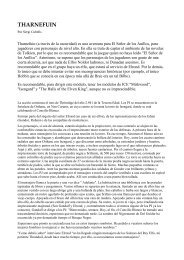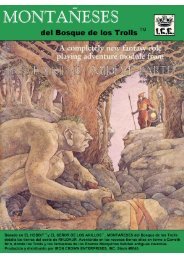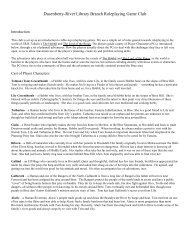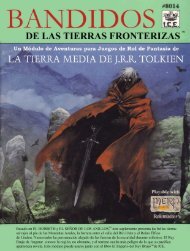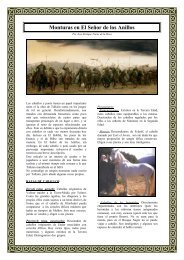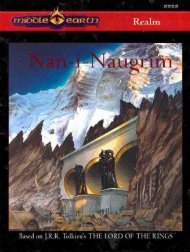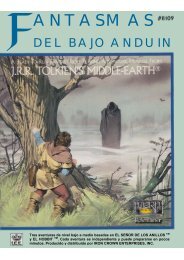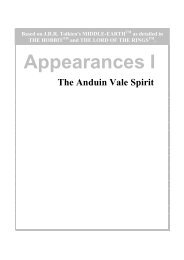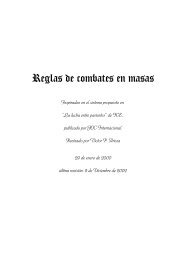bon olivier (order #42065) 83.114.187.4 - Fan Modules - Free
bon olivier (order #42065) 83.114.187.4 - Fan Modules - Free
bon olivier (order #42065) 83.114.187.4 - Fan Modules - Free
You also want an ePaper? Increase the reach of your titles
YUMPU automatically turns print PDFs into web optimized ePapers that Google loves.
ISENGARD<br />
As Saruman casts aside subterfuge<br />
in favour of expediency, many domes<br />
are removed or simply left open<br />
all the time. During the period of<br />
Gandalf ’s imprisonment, many shafts<br />
are enlarged greatly. The time for<br />
careful craftsmanship is gone; crude<br />
expansion that creates great gashes in<br />
the ground, through which carts can<br />
pass and entire trees thrown down, is<br />
the <strong>order</strong> of the day.<br />
t h e C r e s C e n t l a k e<br />
Water flowed from Methedras and<br />
into the basin long before Men came<br />
to the place, and they found a shallow<br />
pool covering much of its area. Rather<br />
than divert the stream that fed this<br />
pool, the artisans of Gondor saw that<br />
the fortress’ residents would benefit<br />
from a supply of fresh water within the<br />
ring-wall. As they covered the ash with<br />
dirt, they shaped the pool into a crescent-shaped<br />
lake east of Orthanc. This<br />
is the Crescent Pool of Isengard, more<br />
commonly called the Crescent Lake.<br />
The Crescent Lake is not large, nor<br />
deep. Fed by the mountain, however,<br />
it is both cold and clear. A tall Man<br />
could wade across, the waters reaching<br />
no higher than his chest. The pool<br />
empties into the caverns below, feeding<br />
underground streams that flow<br />
beneath the Wizard’s Vale to destinations<br />
unknown even to the Orcs<br />
inhabiting the underground warrens.<br />
Fish find their way into the lake,<br />
carried by the stream. Most are long<br />
and silvery, and often blind, born in<br />
deep caves before the stream thrust<br />
them into the light. Many are caught<br />
and eaten, though by decree the lake<br />
may never be completely emptied.<br />
Smooth rocks line the bottom of<br />
the lake, the accumulation of centuries,<br />
worn smooth by the gentle motions<br />
of the waters. Clams, brine, and other<br />
small seafood occasionally appear,<br />
though these are plucked and cooked<br />
without mercy or conservation.<br />
Of all the basin’s natural and architectural<br />
features, the Crescent Lake<br />
alone is undisturbed by Saruman’s<br />
ambitions. Some believe the Wizard<br />
recognises the value in fresh water<br />
close at hand. Others imagine it is<br />
a single concession to his old love<br />
of beauty and nature. Cynics suspect<br />
the mage leaves it untouched for<br />
some more sinister reason. Yet all the<br />
Men in Isengard appreciate the decision,<br />
for the lake is calm and serene.<br />
Many sit along its bank, or perch on<br />
the bridge at their work’s end—especially<br />
those who are unhappy with<br />
Saruman’s ‘progress’—seeking a few<br />
calm moments to cast their minds<br />
back to the days when Isengard was<br />
more beautiful, and less industrious.<br />
u n d e r g r o u n d<br />
‘Iron wheels revolved there endlessly… .<br />
plumes of vapour steamed from the vents,<br />
lit from beneath with red light, or blue, or<br />
venomous green.’<br />
— The Two Towers<br />
For sheer volume, the largest portion<br />
of Isengard proper is not<br />
Orthanc, the ring-wall, or even the<br />
basin of Isengard. The majority of<br />
Saruman’s domain lies, instead, below<br />
the ground in caverns that riddle<br />
the rock. Though the builders of<br />
Angrenost discovered many of these<br />
holes and caves, they thought little<br />
of them, or when they did attend<br />
to them—such as when Curugond<br />
descended to handle the bandúrhoth<br />
he discovered beneath the earth (see<br />
page 96)—resolved to do so as infrequently<br />
as possible.<br />
So the caverns were ignored for<br />
long centuries—at least by the Men<br />
above. But over time, Orcs migrated<br />
from the mountains into the tunnels<br />
beneath the fortress, and made<br />
homes in their twisting passages, hidden<br />
from the light of day. These creatures<br />
found no way up into the basin,<br />
though, and saw no reason to search<br />
for one, so they lived below and the<br />
Men above, neither race really aware<br />
of the other’s presence.<br />
Even when the Dunlendings<br />
claimed Isengard, the Orcs remained<br />
hidden. By this time they had discovered<br />
that Men lived above, but without<br />
knowing their strength or comportment,<br />
it was judged safer to avoid<br />
encounters than risk being chased<br />
away or slaughtered.<br />
When Saruman first took Orcs as<br />
slaves and servants (see ‘The Road to<br />
Udûn’ on page 14), these alerted him<br />
to the presence of the existing Orcs<br />
in the depths. He quickly dominated<br />
those as well, and for many years<br />
all his Orc-chattel remained hidden<br />
even from the Men of Isengard, doing<br />
little for Saruman beyond mining,<br />
scouting the caverns, and protecting<br />
their warrens from interlopers.<br />
<strong>bon</strong> <strong>olivier</strong> (<strong>order</strong> <strong>#42065</strong>) 8


